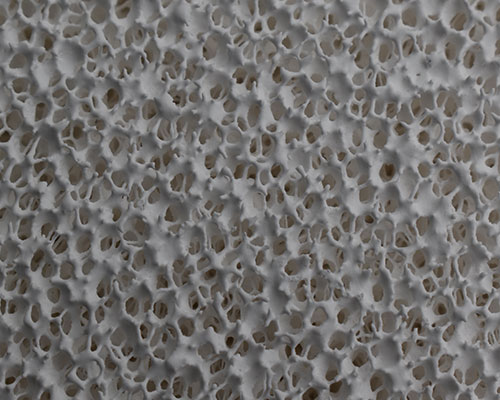The porous foam ceramic filters use polyurethane foam as a carrier, immerses it in a coating made of ceramic powder, binder, sintering aid, suspending agent, etc., and then extrude the excess coating to uniform the ceramic coating ground applied to the carrier. The skeleton becomes a green body, and the green body is dried and fired at a high temperature.
Porous ceramic foam filters are divided into bonded types and sintered types. The former relies on a binder to bond fine ceramic particles together, while the latter relies on high-temperature insulation to sinter relatively pure ceramic fine particles.
The porous foam ceramic filters have a unique three-dimensional connected curved pore network structure, with porosity as high as 80% to 90%, and have the following three filtration and purification mechanisms.
1. Mechanical interception
2. Rectifier scum
The rectification effect of the filter makes the flow channel located in front of the filter so that the filtered aluminum water is in a smooth laminar flow state, and the oxidation and corrosion reaction of aluminum is weakened so that the inclusions are easy to float and trap, and the filter reduces the reduction The number of secondary inclusions is reduced.
3. Deep adsorption
The fine inclusions that enter the filter are attracted to the skeleton or remain in the dead space of the mesh due to full contact with the ceramic mesh with complex flow paths.
Through these three filtering and purification mechanisms, it can effectively filter out large inclusions and a large amount of small suspended matter as small as tens of microns in the aluminum liquid. The filtration efficiency of the ceramic foam filter is as high as 95%, which is greatly reduced. Casting scrap rate and weld repair rate.

In addition, it simplifies the gate system and improves the metallurgical structure, thereby increasing the output and productivity of the casting process, and improving the internal quality, workability, and workability of the casting.
Therefore, the ceramic foam filter has a good application prospect.
In the production of castings, the rejection rate of castings due to casting defects (such as non-metallic inclusions) is usually as high as 50% to 60% of the total number of rejections. Inclusion defects not only severely reduce the mechanical properties of the casting but also adversely affect its processing performance and appearance. Purifying liquid casting alloys and reducing or eliminating various non-metallic inclusions is undoubtedly a very important technical measure to obtain high-quality castings. This porous ceramic foam filter filtering technology can effectively achieve the purpose of purifying liquid casting alloys.

